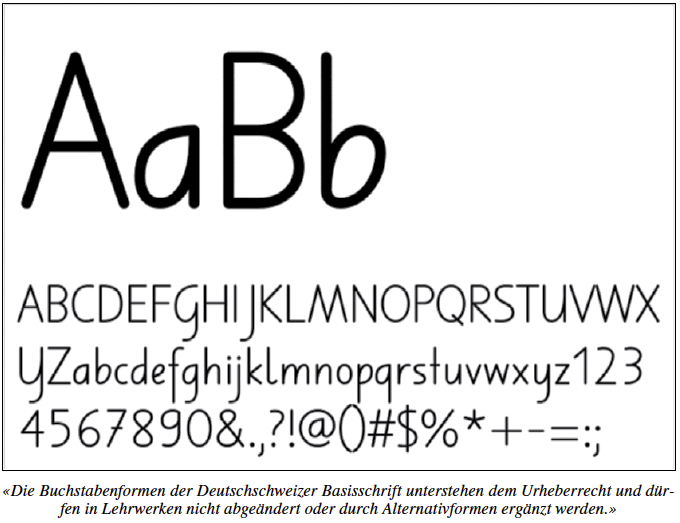Thank God we have the German-speaking Swiss Conference of Cantonal Ministers of Education
Thank God we have the German-speaking Swiss Conference of Cantonal Ministers of Education
by Michael Schewski, real-life satirist
Recently, I read in various newspapers that on recommendation of the German-Speaking Swiss Conference of Cantonal Ministers of Education, in all primary schools the “Schnürlischrift” (cursive script) will be abolished with the introduction of Curriculum 21 and that a new “Basisschrift” (a simplified form of handwriting) will be taught instead. Intrigued, I looked at the web page of the German-speaking Swiss Conference of Cantonal Ministers of Education. There I found the “Instruction sheet for the use of the “Swiss-German ‘Basisschrift’”, describing everything in detail from its correct use all the way up to the right of use. The combined word/figurative mark “Swiss-German ‘Basisschrift’” is actually protected by trademark laws.
Until now, pupils learned to write in a two-stage approach, first the unconnected printing of letters and then the fully connected “cursive script” with partially new letter images. In this way the individual handwriting was developed.
In order to spare the pupils this detour in future, they are supposed to learn only one letter form that of the Swiss-German “Basisschrift”, initially unconnected. Later the letter connections would be set by the pupils “individually”.
With the new letter shapes, unnatural movements with many changes of direction would be avoided. That would mean an adaptation to the needs of the beginners. The paper helpfully explains, that the fonts of the Swiss-German “Basisschrift” contained only unconnected characters. There were no partially cursive letters. The concept of the “Basisschrift” was characterised by the very fact that pupils would individually work out the connections themselves after having learned the individual letters. A digitized template of partly related typeface would be contrary to the concept of the “Basisschrift”. Neither could a template with unconnected, but diagonally specified letters (possibly with letter endings) – be recommended. The Italic Script was the consequence of an obliquely set sheet, the paper explains. An obliquely set script template, however, but would entice the children to bend their wrists, which was neither ergonomic nor useful for fluid handwriting. – Wow, ain’t that something …!
And then I read the effectuations of a teacher who boasted to a newspaper of having already introduced the “Basisschrift” last summer, two years before it became compulsory in her canton. She claims that the “Basisschrift” was a simplification compared to the cursive script, which made it possible to practice the essentials more efficiently. The children had thus more capacity to focus on the contents of a text and would have to pay less attention to the correct way of writing the letters. –
Slowly the images of our ancestors’ bent wrists appeared before my mind’s eye. Since they had no German-speaking Swiss Conference of Cantonal Ministers of Education, they unknowingly filled entire books with slanted connected letters. And I began to imagine what the poets and thinkers of yesteryear might have achieved if they had not been forced to concentrate on proper handwriting. ...
But next it dawned on me that the whole matter was not completely thought through to the end: Firstly, any indication of what to do with pupils who practice cursive script in secret, is missing on the website of the German-speaking Swiss Conference of Cantonal Ministers of Education. And secondly, why bother with this intermediate step? Has there not been a software available since long that converts speech into writing? … •
